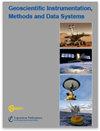开发粘土矿物分离、表征和 40K/40Ar 测年综合分析平台
IF 2.3
4区 地球科学
Q3 GEOSCIENCES, MULTIDISCIPLINARY
Geoscientific Instrumentation Methods and Data Systems
Pub Date : 2024-06-14
DOI:10.5194/egusphere-2024-1150
引用次数: 0
摘要
摘要。同位素测年是一种宝贵的方法,可用于确定岩石圈过程的时间:地球动力事件、矿石沉积和地热机制。K-Ar 测定年代技术的主要优点是适用于在不同温度(从岩浆温度到低温温度)下结晶的无处不在的含钾矿物。在所有含 K 矿物中,粘土具有重要意义,因为它们是在各种水热动力学过程中结晶的。然而,用 K-Ar 方法测定伊利石的年代并不简单。伊利石的 K-Ar 年代通常依赖于混合同位素信号,这种信号指的是可能经历过同位素重置或再结晶过程的各种伊利石群。因此,对伊利石进行可靠的 K-Ar 测定取决于:(1) 对大量粘土组分进行粒度分离;(2) 对形态、矿物学和结晶学进行研究;(3) 对每种粘土粒度组分进行精确的 K-Ar 测定;(4) 利用末段年龄或伊利石年龄分析(IAA)方法对年龄进行有意义的解释。本文介绍了洛林大学地质资源实验室最近为获得伊利石混合物有价值的年龄而开发的仪器和方法。本文章由计算机程序翻译,如有差异,请以英文原文为准。
Development of an integrated analytical platform of clay minerals separation, characterization and 40K/40Ar dating
Abstract. Isotopic dating is a valuable method to constrain the timing of lithospheric processes: geodynamic episodes, ore deposition and geothermal regimes. The K-Ar dating technique has the main advantage of being applied to ubiquitous K-bearing minerals that crystallize in various temperatures, from magmatic to low temperatures. Clays are of significant interest among all K-bearing minerals, as they crystallize during various hydro-thermo-dynamic processes. Nonetheless, the dating of illites by the K-Ar method is not straightforward. K-Ar dates on illite usually rely on a mixed isotopic signal referring to various illitic populations that might have experienced isotopic resetting or re-crystallization processes. Therefore, reliable K-Ar dates on illite depend on (1) the grain size separation of large amounts of clay fractions, (2) the study of the morphology, mineralogy and crystallography, (3) the determination of precise K-Ar dates on each clay size fraction and (4) the meaningful interpretation of ages using either end-member ages or the Illite-Age-Analysis (IAA) method. This paper describes the instrumentation and methods recently developed at the GeoRessources laboratory of the University of Lorraine to obtain valuable ages on illite mixtures.
求助全文
通过发布文献求助,成功后即可免费获取论文全文。
去求助
来源期刊

Geoscientific Instrumentation Methods and Data Systems
GEOSCIENCES, MULTIDISCIPLINARYMETEOROLOGY-METEOROLOGY & ATMOSPHERIC SCIENCES
CiteScore
3.70
自引率
0.00%
发文量
23
审稿时长
37 weeks
期刊介绍:
Geoscientific Instrumentation, Methods and Data Systems (GI) is an open-access interdisciplinary electronic journal for swift publication of original articles and short communications in the area of geoscientific instruments. It covers three main areas: (i) atmospheric and geospace sciences, (ii) earth science, and (iii) ocean science. A unique feature of the journal is the emphasis on synergy between science and technology that facilitates advances in GI. These advances include but are not limited to the following:
concepts, design, and description of instrumentation and data systems;
retrieval techniques of scientific products from measurements;
calibration and data quality assessment;
uncertainty in measurements;
newly developed and planned research platforms and community instrumentation capabilities;
major national and international field campaigns and observational research programs;
new observational strategies to address societal needs in areas such as monitoring climate change and preventing natural disasters;
networking of instruments for enhancing high temporal and spatial resolution of observations.
GI has an innovative two-stage publication process involving the scientific discussion forum Geoscientific Instrumentation, Methods and Data Systems Discussions (GID), which has been designed to do the following:
foster scientific discussion;
maximize the effectiveness and transparency of scientific quality assurance;
enable rapid publication;
make scientific publications freely accessible.
 求助内容:
求助内容: 应助结果提醒方式:
应助结果提醒方式:


